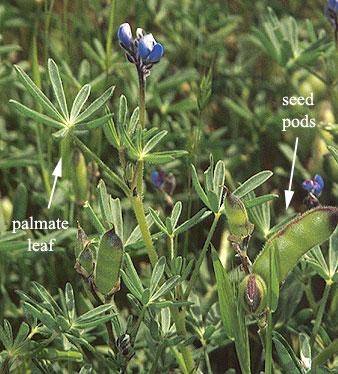Form and Function
The Miniature Lupine grows racemes as part of its morphology. A
raceme is a stalk, off of which flowers branch in whorls. Each flower
is grown off of a short stem with the youngest flowers growing from the
tip of the raceme while the older flowers are lower on the stalk (Wildflower
Center 2013). This is shown well in Image 10. While the younger flowers may still be blooming,
older flowers may be
developing fruit already, lower on the raceme as shown in
Image 5.
in whorls. Each flower
is grown off of a short stem with the youngest flowers growing from the
tip of the raceme while the older flowers are lower on the stalk (Wildflower
Center 2013). This is shown well in Image 10. While the younger flowers may still be blooming,
older flowers may be
developing fruit already, lower on the raceme as shown in
Image 5.
The flowering structure of the Miniature Lupine is made up of five sepals (Dunn 1956). There is one large, and two partially fused sepals on top and two smaller ones on the bottom. These bottom sepals are fused to form a bowl like structure. The five sepals are all fused into the carpel which will become the fruiting body once pollination has occurred.This small flower self-fertilizes, often not needing a pollinator at all (Karoly 1994).
Image 10. (above to the right) Photo of the Lupinus bicolor, showing the beautiful coloring of the petals as well as the raceme formation of the flowers. Photo taken by Darlisa Black.
The term bicolor, refers to the coloring pattern of the Miniature Lupine. Bicolor simply meaning “of two colors,” an indigo and white can be seen clearly in all images in the gallery as well as on this page. When the flower is developed and opens the color of the top petal is white, bright and attractive to pollinators. Once the flower is pollinated the large petal darkens into a lavender color, no longer attracting pollinators (SPLASH 2013). The pollen travels into the carpel, which contains the ovaries. These fertilized eggs become the fruiting body of the plant.
 The
L. bicolor grow fuzzy pea pods as their fruit. These pods are
about 10-15mm long and contains 5-8 ovules which are brownish in
color, once dried
(Dunn 1956). As the pod dried out pressure builds up. The pod
than forcefully splits open along two sides, the seeds are
released and expelled up to 20 feet away from the parent. The
explosiveness of the pea pods is a mechanism of
reproduction. As shown in Image 5, the
seeds are a green color, as they dry out they become brown.
The
L. bicolor grow fuzzy pea pods as their fruit. These pods are
about 10-15mm long and contains 5-8 ovules which are brownish in
color, once dried
(Dunn 1956). As the pod dried out pressure builds up. The pod
than forcefully splits open along two sides, the seeds are
released and expelled up to 20 feet away from the parent. The
explosiveness of the pea pods is a mechanism of
reproduction. As shown in Image 5, the
seeds are a green color, as they dry out they become brown.
Lupinus bicolor consists of palmate leaves, named because they resemble an opened supine hand. As shown in Image 5, these leaves are in a group of seven all stemming from the end of a petiole (Lance 2013). These leaves contain chlorophyll and allow the plant to photosynthesize, making sugars to form the body parts, fruit, flowers and also to feed the root cells, who cannot make an energy source for themselves.
Image 5. (Above) The L. bicolor showing palmate leaves and seed pods. Photo by Carol Witham.
The miniature lupine is an annual plant, this means that it completes an entire lifecycle in a one year span. These plants go from seed to adult, flower to making more seeds with in a 12 month period (Wildflower Center). This also means that the organism dies at the end of this cycle. The seeds a parent has dispersed, grow into new plants the following year, and the cycle continues.
Go back to Habitat or move forward to Reproduction.